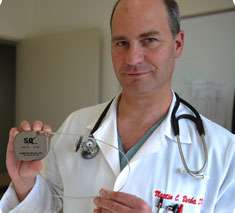Study confirms performance of new defibrillator with no heart leads

(PhysOrg.com) -- Results from clinical trials performed in Europe and New Zealand, published online in the New England Journal of Medicine, demonstrate the effectiveness of a new less-invasive, subcutaneous implantable cardioverter defibrillator (ICD) for sudden cardiac arrest, a potentially fatal electrical malfunction of the heart.
The subcutaneous ICD replaces the leads that extend into the heart with sensors and a shock-delivery device placed just beneath the skin over the sternum.
Four studies conducted at eight sites in Europe found that the S-ICD detected 100 percent of induced and spontaneous irregular heart rhythms with 98 percent conversion success. They confirmed that the leadless defibrillator helped reduce problems associated with traditional models, including difficulty implanting the leads, risk of damage to the heart or the device, chance of infection and the need to remove a defective or damaged electrode in or on the heart.
The device received European approval in 2009 and is commercially available there. The publication represents nine years of development and clinical work with 17 medical centers in seven countries. The first U.S. recipient of the device had it implanted March 3, 2010 at the University of Chicago Medical Center.
"The studies show that the S-ICD is ideal for relatively young, healthy patients at high risk of cardiac arrest, but who don't need a pacemaker," said Martin Burke, DO, director of the Heart Rhythm Center at University of Chicago Medical Center.
While the added distance from the heart means a more powerful shock is delivered by the S-ICD (about 2.5 times stronger than traditional ICDs), the power is still well within a safe range, Burke said. And patients should experience fewer of those shocks, thanks to an improved monitor system that measures more complex heart rhythm characteristics to separate out dangerous cardiac events from false positives.
If an infection related to the device should occur, it would be less dangerous in that location. Removing the device, if necessary, would be much simpler with no cardiac leads.
The researchers plan to enroll up to 330 subjects in a new, larger trial underway at about 35 sites globally, including Chicago, Los Angeles and Atlanta. In the Chicago area, the device is currently available only at the University of Chicago Medical Center.
The first U.S. patient to receive the device was Brooke Bergeron, 38, who was 37 weeks pregnant when she suffered a heart attack, a rare complication of her fourth pregnancy. After the child was delivered via caesarian section and the mother underwent an emergency double-bypass operation, Bergeron's doctors recommended an implantable defibrillator.
Because of her young age, normal heart rate and high risk of cardiac arrest, Bergeron was an ideal candidate for a device without leads, which can be damaged over time.
"Cameron Health's goal in developing the S-ICD System was to significantly improve upon current ICD therapy by reducing the complications associated with transvenous leads, as well as to simplify implantation, programming and follow-up," said Kevin Hykes, President and Chief Executive Officer, Cameron Health, Inc.
"The publication of these data is a clear acknowledgement of the important pioneering contributions made by the clinical investigators. We believe that the S-ICD System has the capability to significantly lower adoption barriers, increase patient acceptance and ultimately save more lives."
















